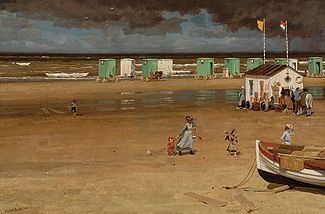Ludolph Berkemeier
- Machine translation, like DeepL or Google Translate, is a useful starting point for translations, but translators must revise errors as necessary and confirm that the translation is accurate, rather than simply copy-pasting machine-translated text into the English Wikipedia.
- Do not translate text that appears unreliable or low-quality. If possible, verify the text with references provided in the foreign-language article.
- You must provide copyright attribution in the edit summary accompanying your translation by providing an interlanguage link to the source of your translation. A model attribution edit summary is
Content in this edit is translated from the existing German Wikipedia article at [[:de:Ludolph Berkemeier]]; see its history for attribution. - You may also add the template
{{Translated|de|Ludolph Berkemeier}}to the talk page. - For more guidance, see Wikipedia:Translation.

Ludolph Georg Julius Berkemeier (20 August 1864, Tilburg - 18 July 1930, Noordwijk)[1] was a Dutch landscape and cityscape painter; associated with the Düsseldorfer Malerschule and the Hague School.
Biography
For two years, he attended the Kunstakademie Düsseldorf, where he studied landscape painting with Eugen Dücker.[2] While there, he came under the influence of the newly emerging Barbizon school. Upon graduating, he took a study trip to Wiesbaden.
He continued his studies at the Weimar Saxon Grand Ducal Art School, where he worked with Theodor Hagen, an early German Impressionist.[2] But, despite a brief flirtation with that style, when he returned to the Netherlands he found himself more attracted to the Hague school, which was heavily influenced by the Realism of the Barbizons. He eventually settled in Baambrugge.
In 1896, he suddenly decided to move to Noordwijk, where he established a studio and sold painting supplies. Later, he was able to qualify for a government pension. He continued to develop his style by taking lessons in plein aire painting from Jan Hillebrand Wijsmuller,[2] who was an occasional visitor to the area, and collaborated with him on several works.
Many of his landscape paintings incorporate genre elements. He also created numerous still-lifes and book illustrations. For many years, he was an active member of Arti et Amicitiae.[2] A small street in Noordwijk has been named after him.[3]

References
Further reading
- Baumgärtel, Bettina: Die Düsseldorfer Malerschule und ihre internationale Ausstrahlung 1919–1918, Michael Imhof Verlag, Petersberg 2011, ISBN 978-3-86568-702-9
- Bernt, Walter: Die Niederländischen Maler und Zeichner des 17. Jahrhunderts, Vol.2, Bruckmann Verlag, Munich 1980, ISBN 978-3-7654-1766-5
External links
 Media related to Ludolph Berkemeier at Wikimedia Commons
Media related to Ludolph Berkemeier at Wikimedia Commons
- v
- t
- e
painters
- Victoria Åberg
- Andreas Achenbach
- Oswald Achenbach
- Hermann Anschütz
- Peter Nicolai Arbo
- Louis Asher
- Anders Askevold
- Hans von Bartels
- William Holbrook Beard
- August Becker
- Jakob Becker
- Gunnar Berg
- Edward Bergh
- Ludolph Berkemeier
- Edward Beyer
- George Caleb Bingham
- Georg Bleibtreu
- Arnold Böcklin
- Friedrich Boser
- Anton Bütler
- Joseph Niklaus Bütler
- Alexandre Calame
- Wilhelm Camphausen
- August Cappelen
- Gustaf Cederström
- Fanny Churberg
- Johann Wilhelm Cordes
- Ludwig des Coudres
- Ernest Crofts
- David Edward Cronin
- Hans Dahl
- Ernst Deger
- Eugen Dücker
- Ferdinand Fagerlin
- Julius Geertz
- Hans Gude
- Lars Hertervig
- Marcus Larson
- Karl Friedrich Lessing
- Ascan Lutteroth
- Albert de Meuron
- Heinrich Mücke
- Bengt Nordenberg
- Victorine Nordenswan
- Axel Nordgren
- Sofie Ribbing
- Raphael Ritz
- Friedrich Wilhelm Schadow
- Caspar Scheuren
- Johann Wilhelm Schirmer
- Adolf Schrödter
- Theodor Schüz
- Karl Ferdinand Sohn
- Eduard Steinbrück
- Hermine Stilke
- Bernhard Studer
- Zdzisław Suchodolski
- Adolph Tidemand
- Carl d'Unker
- Clara von Wille
- Fritz von Wille
- Kilian Zoll










